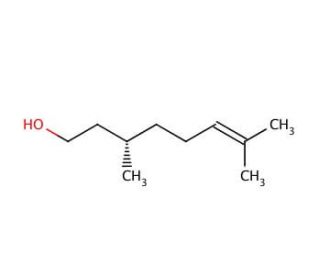

L-Citronellol (CAS 7540-51-4)
QUICK LINKS
L-Citronellol is a compound that is widely researched in the field of organic chemistry due to its importance as a naturally occurring fragrance. It is extensively studied for its olfactory properties and is used as a key ingredient in the formulation of various scents and flavorings. The compound′s role in the synthesis of other fragrance chemicals, particularly through chemical reactions that involve the modification of its functional groups, is also a subject of interest. In addition to its applications in perfumery, L-citronellol is used in studies on plant-insect interactions, as it is a major component of the essential oils of several plant species that serve to repel or attract specific insects. Its enantiomeric purity is another area of focus, as the L-enantiomer has a different scent profile compared to its racemic mixture or the D-enantiomer.
L-Citronellol (CAS 7540-51-4) References
- Characterizing complex chemosensors: information-theoretic analysis of olfactory systems. | Alkasab, TK., et al. 1999. Trends Neurosci. 22: 102-8. PMID: 10199633
- Composition of the volatile oil from Chamaecyparis lawsoniana stump heartwood. | KRITCHEVSKY, G. and ANDERSON, AB. 1955. J Am Pharm Assoc Am Pharm Assoc. 44: 535-8. PMID: 13251926
- Biotransformation of terpenoids by mammals, microorganisms, and plant-cultured cells. | Ishida, T. 2005. Chem Biodivers. 2: 569-90. PMID: 17192005
- Fragrance material review on dl-citronellol. | Lapczynski, A., et al. 2008. Food Chem Toxicol. 46 Suppl 11: S103-9. PMID: 18640206
- Fragrance material review on l-citronellol. | Lapczynski, A., et al. 2008. Food Chem Toxicol. 46 Suppl 11: S110-3. PMID: 18640228
- The feasibility of growing cells of Saccharomyces cerevisiae for citronellol production in a continuous-closed-gas-loop bioreactor (CCGLB). | Arifin, AA., et al. 2011. Bioresour Technol. 102: 9318-20. PMID: 21835610
- Inhibitory effects of geranium essential oil and its major component, citronellol, on degranulation and cytokine production by mast cells. | Kobayashi, Y., et al. 2016. Biosci Biotechnol Biochem. 80: 1172-8. PMID: 26927807
- Cobalt-Catalyzed Esterification of Amides. | Bourne-Branchu, Y., et al. 2017. Chemistry. 23: 10043-10047. PMID: 28594064
- Review of aromatherapy essential oils and their mechanism of action against migraines. | Yuan, R., et al. 2021. J Ethnopharmacol. 265: 113326. PMID: 32877718
- Impact of citronellol on river and soil environments using non-target model organisms and natural populations. | Pino-Otín, MR., et al. 2021. J Environ Manage. 287: 112303. PMID: 33714735
- A 'push-pull-restrain' strategy to improve citronellol production in Saccharomyces cerevisiae. | Jiang, G., et al. 2021. Metab Eng. 66: 51-59. PMID: 33857581
- Aldehyde Production in Crude Lysate- and Whole Cell-Based Biotransformation Using a Noncanonical Redox Cofactor System. | Richardson, KN., et al. 2020. ACS Catal. 10: 8898-8903. PMID: 34306803
- Evaluation of volatile compound profiles and sensory properties of dark and pale beers fermented by different strains of brewing yeast. | Paszkot, J., et al. 2023. Sci Rep. 13: 6725. PMID: 37185768
Ordering Information
| Product Name | Catalog # | UNIT | Price | Qty | FAVORITES | |
L-Citronellol, 1 g | sc-207796 | 1 g | $45.00 |
